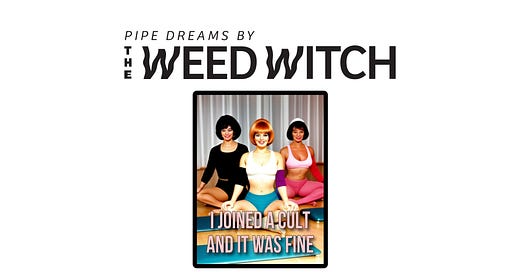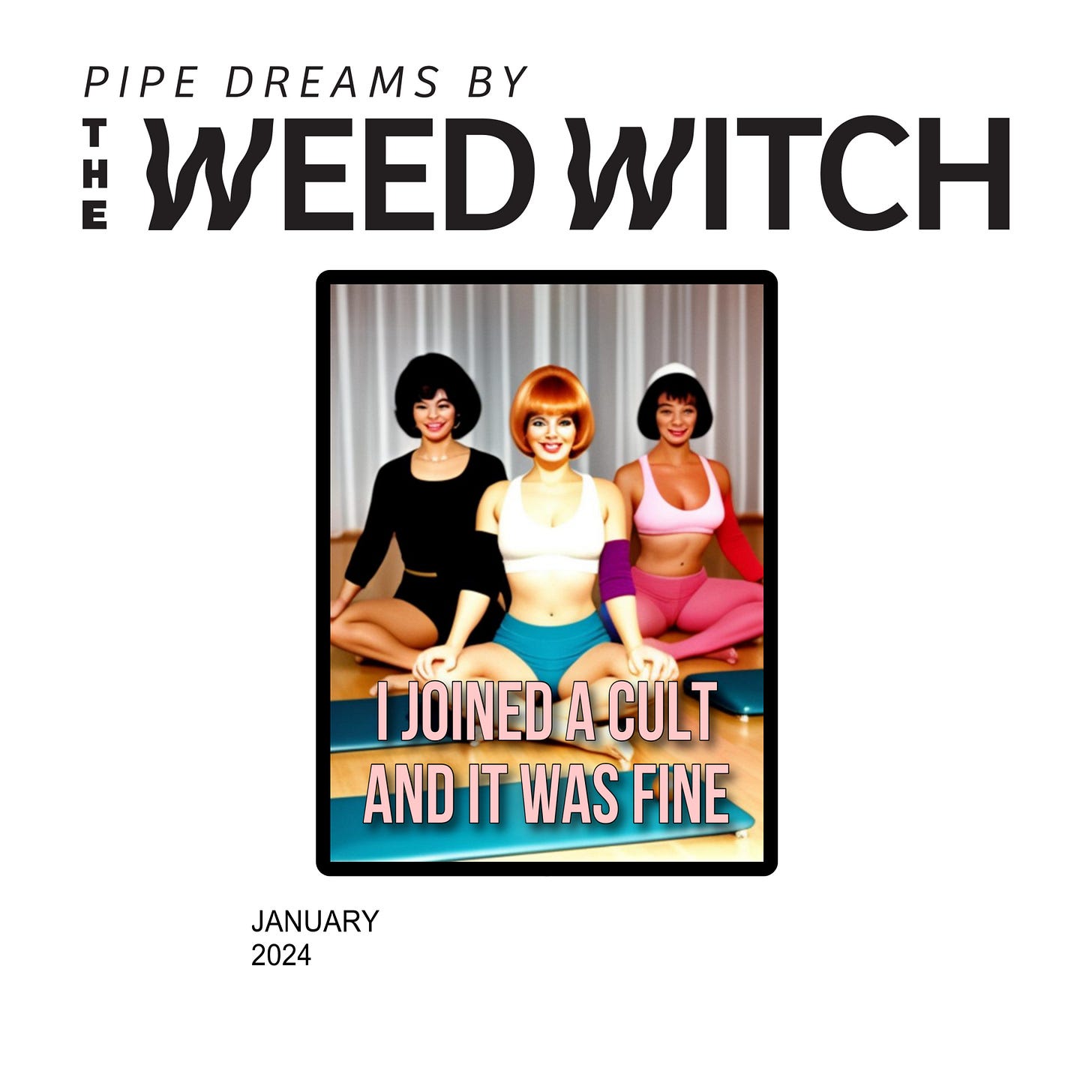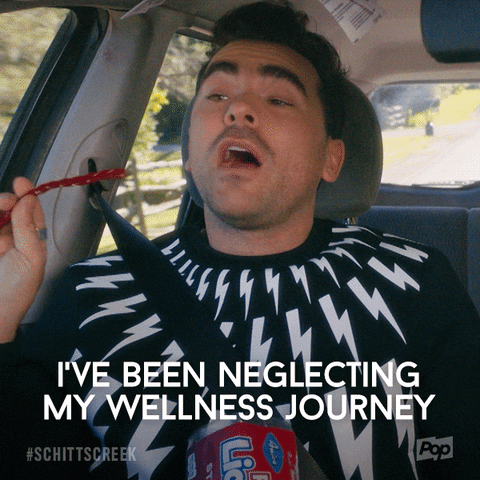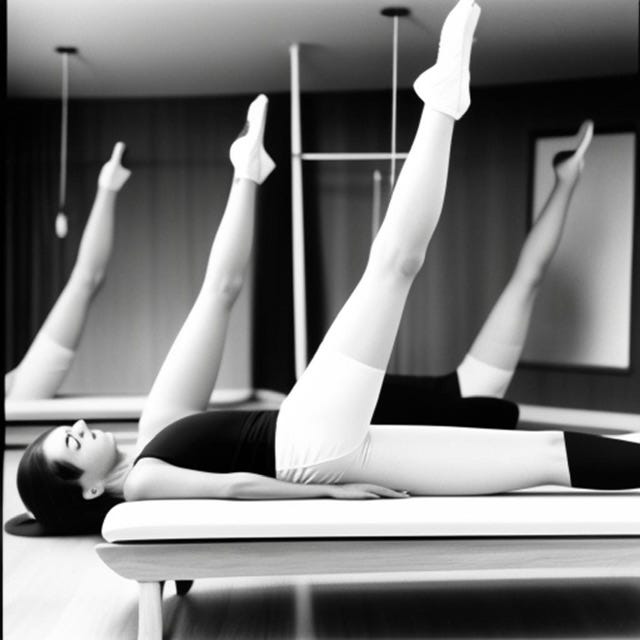I Joined A Cult and It Was Fine
Everything you never needed to know about a wellness journey you never asked for, plus two recipes to get started
Hey everyone,
Believe it or not, I started writing this from my bed on Labor Day, fresh from passing my final Pilates certification exam—something I’ve mentioned a time or thrice without offering too many details—as I celebrated the time-honored American bank holiday by remaining completely immobile with a cup of coffee and ample supply of weed. Seeing as I was still in the middle of the journey, not at the tail end of it, I realized I should probably finish that first. But given that it’s now 2024 and I’ve been living so well lately, I decided that now was as good a time as any to tell you all about my wellness journey (even though you never asked it)!
By the way, did you know that I was on a wellness journey? It started back in April. And it would be a complete tragedy and total waste of a tax write-off if I did not capitalize on this incredible moment of personal transformation like so many of my heroes: Kate Hudson, Beyonce, Carrie Underwood, and of course, wellness industry icon, Gwyneth Paltrow. Even Oscar-winning actress Hilary Swank has an athletics line, which I guess makes sense considering Million Dollar Baby came out like 15 years ago.
Honestly, I didn’t say anything sooner because I was kind of humiliated about it. Succumbing to my full GOOP transformation and brainwashing myself into keto to become a Pilates teacher who does tarot and weed astrology while watching all 11 seasons of the “X-Files” and 13 of “King of the Hill” sounds like the kind of thing I would have only done to be ironic, and yet here I am: a woman who went on a wellness journey. I even got a bunch of sunscreen that I use daily now and have opinions about five- to twelve-step beauty regimes. Who am I?! A woman that looks fab-u-lous!
Sure, I could just go on the wellness journey and not say anything about it. But if a woman goes on a wellness journey and no one knows about it, did it even happen?
Actually, that’s why I started documenting my progress back in 2017 after being paid a kill-fee for my juice cleanse story to avoid ruining a relationship with an advertiser that clearly does not have a good sense of humor. Shortly thereafter, I was issued another kill-fee for a reported and edited story on mushroom coffee in Bon Appetit’s spin magazine, Healthyish (that included interviews with Moon Juice empress Amanda Bacon Chantal, a licensed nutritionist from John Hopkins University, and the folks at Cafe Gratitude, the place that makes you thank your beverage as you order) because I guess I noted that this was “the kind of thing that could only trend in L.A. unless it tasted good” (not wrong) and made a bunch of jokes (again) because that’s the only way I can relate.
Cannabis seemed like a smart way to keep digging my heels into an industry that clearly didn’t want me, so I offered my smartest piece of advice: if you don’t buy shitty food, you don’t have it in your house when you get the munchies; eat a salad. But who wants to hear some bitch stating the obvious? Of course, salads are the healthier choice. Everyone knows that. The issue is that many salads in health and diet magazines are unimaginative and flavorless, in part, because you’re often simultaneously addressing inflammation and other health-related symptoms through gentle nutrition. The creative alternative is usually some high voltage recipe in a food glossy that claim to be two ingredients yet somehow has 10—half of them being niche investments just for that one recipe. Surely, there has to be an in-between; it just hasn’t made it to Trader Joe’s quite yet.
Which begs the question: how did I go from gluttonous professional food writer with zero hang-ups to a Pilates practitioner on a highly restrictive diet without developing a full-on ED and toxic personality disorder?
Truth be told, taking care of my health and reframing my relationship with food was prompted by the pandemic (ugh). Before that, my body was simply a vessel prepared to consume anything: a 14-course tasting menu at a fine dining restaurant, a bunch of fried appetizers I never asked for being sent out as a gift from the kitchen, judging a baked goods competition at a maple syrup festival, blind tasting 200 wines over an educational lunch. I mean, it was literally my job for two decade.
“Never trust a skinny chef” was the M.O. in the food world before the pandemic, even at detriment to the human guinea pigs in question. Most “normal” people I’d bring to industry events would get physically ill because that’s how much food and beverage there was and you were expected to taste it all. That was my relationship with food: professional, meticulous, and not about me. You can’t really have hang-ups beyond “what do we think of this?” as an industry professional and tastemaker, and nothing about it is relatable, but there’s a real bond, sense of pride, and respect in that work. It’s personal. You just think about it on a totally different level. Don’t get wrong, I’ve had so many absolutely priceless taste memories over the years, but it did come at a certain expense. Trying to bridge that other lifetime with this new, healthier lifestyle felt like a severance to reframe my entire mindset. And I started to wonder why, or if that even necessary.
Unlike food writing where I kind of don’t take anyone’s opinion that seriously, the “wellness community” always somehow manages to piss off everyone, even if you’re speaking from your own experience, because health and wellness is such a triggering topic for so many people. The most controversial thing I dealt with when I started my food writing career in Chicago was arguments over pizza—such a pleasant argument because the only losers are the people who aren’t eating it. Meanwhile, branching into food-adjacent topics like women’s lifestyle started feeling like being back in the high school girls locker room. “Oh shit, you still have an eating disorder even though we’re almost 40?” I absolutely did not want to be shoved into that culture or conversation.
Eating disorders aren’t the type of things foodies talk about; that’s a “wellness” topic. Nutrition really isn’t a foodie topic either, unless it’s a story about a chef having an epiphany that crushing a six-pack and fast food at midnight after every shift for 25 years probably didn’t help their overall deteriorating health problems when they were diagnosed with kidney failure and had to go on dialysis or got cancer and realized that eating organic is essential when you’re pumping your body full of chemo chemicals. Mental health is only important as a food topic when addressing the countless chefs who committed suicide after losing a Michelin star after years of putting these same abusive fine dining temples on a pedestal. After that, back to regularly scheduled programming: does it taste good and which celebrities are on Ozempic.
Witnessing thousands of people dying around you in a month while bodies pile up in cold storage trucks around the corner from where you’re going into the local grocery store feeling like a dystopian character in the movie Contagion, walking through an empty sprawling city once bustling with people, and being sequestered for months in a comfortable apartment prison was undoubtedly traumatizing. Yet, we all picked up, carried on, and got sick of talking about it, while knowing deep down that everyone was going to be a little permanently fucked up—most especially the people in denial.
This super isolating period not only changed my diet, but my mindset, routine, and goals that impacted my overall mental, emotional, and physical health. Instantly losing all of my work covering restaurants that once served as uplifting and inspiring cornerstones of a community that had evolved into resentful social justice factories, I had to turn inward to think about my personal relationship with food and my future career path.
Food and restaurants had represented such a sense of purpose and community for me for so many years that I didn’t know what to do with myself. My community was gone. I wasn’t making TikTok dance videos or building my brand by photographing my depression meals. Instead, I dropped 60 pounds from stress and had a mental breakdown then gained it all back plus some because that is not a healthy or sustainable way to lose weight. Broken is an understatement to describe where I was psychologically and I am grateful to be alive.
Remembering to eat and reconnect with food in a personal, nourishing way, to take care of myself when I had no one to take care of me, and remind myself that acts of self-kindness matter, was a major accomplishment. It was rehabilitative. Because there was no vaccine at the time, I could only rely on improving my immune system by focusing on my diet. Making that change was a life-saving decision, but again, not a foodie topic. Foodie-ism is about the enablement of pleasure and excess—none of which I was experiencing, even when I would receive gift baskets from various publicists that I would eat in social isolation with nowhere to publish.
With a lot of time on my hands and in desperate need of income and social interaction, I started working at a pie shop in Brooklyn thinking it would be a good way to meet other people and mentally disconnect from the internet for a few hours. “Who could ever be mad getting pie and coffee?” Apparently, a lot of the people who live in Park Slope! These are the same people who jump on Facebook every time the New York Times posts something about tipping culture to say, “Why does a barista get a dollar?” while rolling in with $7,000 designer baby carriages as I eat another slice of pie for dinner (I ate all of the pies and have no regrets).
Fifteen pounds later, I finally got another job working for a major tech company ghostwriting think pieces for people who make a lot more money than me. Now making more money than at the pie shop, I invest in a ClassPass that comes with a complementary membership to Blink gym. But the pandemic had triggered a noticeable vibe shift at the gym: heavy breathing, aggressive commandeering of equipment, and TVs blasting incessant reminders of the reality outside those gym walls—not particularly helpful for improving my overall mental and physical health.
Because ClassPass allows you to take any open class using your points, I started looking into more intimate studios and this is how I found Pilates. Starting with reformer classes, I found a studio advertising a cutesy “Tipsy Tuesdays” wine and Pilates class (though, I was the only one who asked about the wine at the end of the class because I guess I’m the only person who would take a free glass of wine after a workout).
Laying on my back listening to the teacher’s verbal cues, I slowly started making a mind-body connection I never anticipated. Simply telling someone to drop their shoulders down and back, to scoop their abdominals in and up, to push in with their heels and lengthen their torso for opposition, to remember to breathe—it’s almost unnatural language about engaging with your body in a very natural way, forcing neural pathways open that connect the body and mind. That mind-body connection helped me regain my focus as I confronted and worked through a lot of my past trauma in therapy. Yes, it sounds hippie-dippy—even if it’s scientifically proven—but not wrong. It works. Not everyone is ready to think, be humbled and learn, but usually better for it when they learn to listen to others and themselves.
I won’t bore you with details about Joseph Pilates (even though I find him very fascinating), but will note that he was a former boxer who developed the art of contrology while interned during WWI (not a Nazi, I checked). Studying yoga and the movement of animals, he developed his own system of physical fitness that he honed over time. Some of his advice can be taken with a grain of salt (most professionals agree that Pilates will not allow you to smoke cigarettes and drink 5 pints of beer every day as he claimed—though I appreciate the sentiment), but overall the structure is very well-rounded and modifiable for all types of bodies—aging, pregnant or injured and sent from their doctors, as well as people just looking to get in shape or engage in preventive health.
I continued doing Pilates through back-to-back contracts, getting stronger mentally and physically, watching my body regain posture and confidence even after spraining my ankle (cheaper and more effective than PT without insurance). As I approached the end of 2022, I had to think about what to do next. It had been a few years since I worked for a magazine and my commissions were very low. In 2019, I had applied to work at Reckless Records in Chicago—a place where I would undoubtedly make minimum wage but everyone at the store agreed that I would be a fit since I had depression and smoked weed. My friends, concerned about my well-being, insisted that I find “a real job” because obviously I had a well-documented career, including a James Beard nomination and a book.
With no real ambition or direction, I had to think seriously about what I wanted. A house would be great, but required money. Working in halogen lit offices made me cry at my desk, so I needed something flexible. Most important: I wanted to keep doing Pilates. But wait, if I become a Pilates teacher, I can do it whenever I want and people will pay me for it! The hours and compensation are good, it’s cheaper than a masters with better ROI, and no one cares that I smoke weed—win-win!
After looking into a few programs, I decided that you can’t kill a classic andaz opted for the comprehensive program and work-study at Core Pilates, a top-rated boutique studio specializing in classical Pilates in the heart of Manhattan. I picked up a part-time job at a PR agency working in industries that had nothing to do with food and thus my hybrid schedule was born.
The program is intensive, earning 600 teaching and training hours in about six months. Realizing I wasn’t doing myself any favors by not paying attention to my diet while trying to push my body, I decided to try out the ketogenic diet, or keto for shorthand: a high-fat, protein heavy, and low carb diet that works to burn fats rather than carbohydrates. Originally used to treat epilepsy in children, it has also shown proven results with weight loss in adults and notably controversial because it can easily be misinterpreted as an excuse to eat cholesterol-laden bacon-wrapped cheese curds, which is obviously not very good for you.
Some definitely get lost in the science and become obsessive about counting macronutrients or testing their urine for ketones, but I wasn’t going that far. Mainly, it made me more conscious about what I was putting in my body and reading labels. Until then, most of my diet had been supplemented by carbs, fruits, legumes, and whatever was on sale. While there’s nothing inherently wrong with shopping this way, none of it fits into this very restrictive diet.
Turning to meal prep, I restocked my fridge and pantry. I threw out pre-packaged sauces and started making my own. I cut back on alcohol after becoming more conscious about that intake, too, because it’s loaded with sugar. I no longer need to participate in the throes of “dry January” because I just don’t have a problem with alcohol anymore. Like many in the wellness industry, some Pilates teachers do smoke weed or are ambivalent about how people use weed to engage in restorative work. The key word is restorative: you can’t show up to a Pilates class stoned. I would never teach Pilates stoned and don’t need to be perma-stoned anyway—it’s good to check in with the real world sometimes and what you’re escaping from.
And, of course, it changed my body: I felt better and looked better. Between Pilates and keto, I dropped 30 pounds—this time in a healthy, sustainable way. I reframed the restrictions so that it wasn’t about what I “can’t eat,” but rather what I can. It made me more creative in that kitchen because there was always some way to modify, giving me the framework and discipline to focus on my studies. It also severed my ties with a need to preserve authenticity, further distancing myself from the food community that had developed a toxic obsession with identity and recipe ownership. Who cares what I put in my salad? It’s my own recipe or a riff off someone else’s because nothing is original and everything is keto.
While it prompted a lot of positive changes, it has challenges. Considering how much you cut out, the diet is kind of expensive because real food is expensive. Butter? Expensive. Avocados and ethically raised meat? Expensive. Organic produce? Expensive. Nuts? Expensive. Keto is possible as a vegetarian or vegan, but challenging without the legumes. Weirdly, I ended up saving a significant amount of money in spite of this because I started watching my budget by becoming more conscious at the store, and since I was eating out less, it had more money in my bank account to pay off my debts and adopt better financial health in the long-run.
It impacted my relationship with restaurants and social engagements. Unable to order from the majority of restaurants, the ones that would accommodate became an awkward interaction. “Are you the keto person?” they’d ask as they drop my plate that would often include a modification misstep. Even noting I was doing keto felt like a huge embarrassment that automatically made everyone mentally check out after bringing it up. No one wanted to talk about it. One friend insisted I never utter the word. Saying “I only eat fine steaks and high-grade sashimi,” would be viewed admirably as a foodie, but labeling the same food as “keto” completely shatters that perception in a conversation. Why?
I realized that I would happily defend anyone with a dietary restriction—except for myself. Most of my friends with restrictions from gluten, dairy, and other specific allergies are capable of figuring out their needs, and once I had the internal list down, I could just make choices that were right for me. The important part was to completely isolate myself in the process by never speaking of it. Most of the time, that just meant not eating out and avoiding people. Totally normal behavior. With more time at home to focus on myself, I became more comfortable with self-acceptance and operating independently.
Ultimately, I transitioned off strict keto back in October after six months. I was heading to France and well-aware that it is a punishable offense to not eat baguettes, croissants, and other baked goods. Even then, I found myself having a good amount of discipline not going hard because I didn’t feel deprived. I even took a Pilates class while I was there through the MindBody app.
When I got back, I found myself gravitating towards those same choices I had adopted without punishing myself if I had a cookie or whatever because I was less inclined to eat them anyway. Eliminating that stuff from my diet didn’t make me miss it, especially when I could get a really good dessert from Off The Wheat at the farmers market or make a fruit compote. I found sugary cocktails to be too viscous and usually leading to a hangover, and if I was going to eat bread, it should probably be worth all the bloating and unnecessary calories. I also found that most of my outlets just didn’t care, even though I think chefs and creativity are desperately needed in this category, no different from cannabis edibles.
For someone who joined two different wellness cults, I somehow became even more of an individual thinker from the herd mentality. I don’t feel part of a “wellness community”—or any community for that matter—and have no intention of joining one. I still volunteer with the same three organizations I always have, work on crafts or go to cultural events and concerts I find interesting, and love treating myself to a face or hair mask, manicure or massage. I go to bed a reasonable hour most days, waking up feeling good and energized. It might make me less cool, but I also think I’m better for it and no longer need resolutions (except to update this newsletter more regularly).
Speaking of, paid subscribers get two recipes after the jump!
Keep reading with a 7-day free trial
Subscribe to Pipe Dreams By The Weed Witch to keep reading this post and get 7 days of free access to the full post archives.









